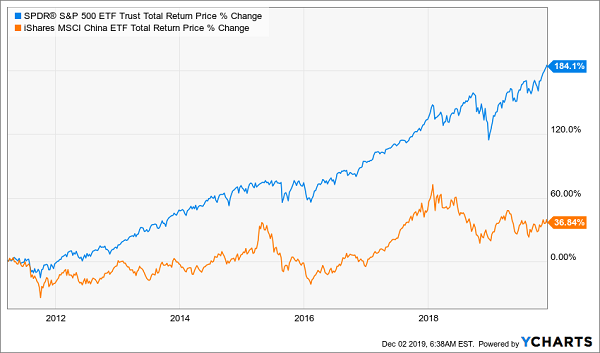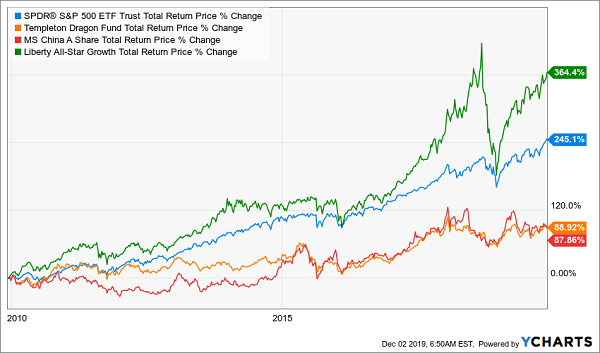Let’s dive straight into a trap I’ve seen many investors make in the past. And falling into this pitfall again today could cost you a 7.7% dividend in 2020, and considerable upside, too.
It involves China’s stock market, which gives all indications of being a bargain today. Too bad it’s anything but!
China Equities Get a Beatdown

Truth is, there do seem to be some screaming bargains in China-focused closed-end funds (CEFs) these days—like the Templeton Dragon Closed Fund (NYSE:TDF), which trades at a 12.1% discount to NAV. Or the Morgan Stanley China Fund (NYSE:CAF), which sports the same 12.1% deal.
But many Americans have been lured into the China story in the past decade, when it looked like the Red Dragon would finally lurch ahead of the US … only to have it end in tears.
Today? It’s no different.
So read on as we dive into a crushing blunder so many folks make when investing in China. Then I’ll show you a much better strategy—and a CEF paying a hefty (and monthly) 7.7% dividend that’s more than worthy of your attention now.
The Lure of China
The trouble with China is that the country’s eye-popping economic growth doesn’t always translate into stock-market success.
Consider the early 2010s, when the flattened subprime mortgage bubble had America’s economy on its knees. It looked like China’s moment had arrived, and investors dutifully plowed cash into China-focused ETFs, like the iShares MSCI China ETF (NASDAQ:MCHI).
Here’s what happened next:
The China Trap Springs

What’s worse is the volatility these folks suffered: look at the whipsawing orange line above, compared to the steady rise of the S&P 500 (in blue).
Today, I’m seeing more than a few shades of 2010: on the surface, the numbers out of China look fairly good: Reuters reports that China’s National Bureau of Statistics has set its sights for 6.2% GDP growth in 2019, on track for the government’s targets.
That just might have you thinking that Chinese stocks, with their weak year-to-date run, are out of whack with China’s economic news, and therefore ripe for buying.
The problem? Beijing’s numbers aren’t always what they appear to be.
For instance, regional data says the government has overestimated GDP growth by 1.7 percentage points annually, according to a study by the Chinese University of Hong Kong and the University of Chicago. That would mean China’s GDP is about 10% smaller than the government claims.
It gets worse. Big economic numbers can be manipulated, but credit markets can’t, and China’s bond market looks frightful. So far, 2019 has seen a record number of bond defaults, surpassing the record set just last year.
Over the last two years, defaults have risen to over $16.7 billion, or a 400% spike! Moody’s Investors Service expects first-time defaults to rise even further in 2020, which could also drive total defaults to yet another new record.
The Safer Play for Bigger Returns—and 7.7% Income
This is why I continue to recommend a focus on US stocks. American companies simply have more trustworthy accounting standards, better regulations and wider global reach.
This is where the beauty of CEFs comes in, because they let you hedge your bets, collecting a large slice of your return in cash, thanks to their high dividends, like the 7.7% paid by the US-equity-focused Liberty All Star Growth Closed Fund (NYSE:ASG)
Large payouts like that also mean you could live on dividends alone, if you’re looking to your portfolio for income, and tune out the market’s ups and downs, because you won’t have to sell any stocks to generate cash.
ASG’s portfolio is a mix of large-cap US stocks like Microsoft (NASDAQ:MSFT), Alphabet (NASDAQ:GOOGL) and Yum! Brands (NYSE:YUM), as well as small- and mid-cap plays like property manager FirstService Corp (NASDAQ:FSV) and education-technology firm Chegg Inc (NYSE:CHGG).
It’s a recipe that’s easily beaten not only the China-focused CEFs—with over four times their total returns in the last decade—but the S&P 500, as well.
ASG Beats Chinese and American Stocks

Remember, much of this return was in cash, thanks to ASG’s large (monthly) dividend. And that payout will continue to provide a nice hedge for ASG investors (as well as a high income stream) through the market’s ups and downs over the coming decade, as well.
My Top 5 Picks for 2020 Crush ASG (8% Dividends, Fast 20% Upside Ahead)
ASG, great as it is, isn’t even one of my 5 top CEF picks for 2020! Those 5 funds pay even bigger dividends than ASG—I’m talking 8% on average, with one of these income stars throwing off a payout above 10%.
That’s not all: unlike ASG, each of these 5 unloved CEFs trades at a huge discount—so much so that I’m expecting 20%+ upside from each of them in the next 12 months.
Look at it this way: if you dropped $100K into these 5 picks today, you could easily be looking at $8,000 in dividend income by this time next year … plus another $20,000 in price upside!
But you must act now, as recent volatility has income-starved investors starting to take note of these funds. Their prices are going up, taking their big discounts (and our upside!) with them.
Disclosure: Brett Owens and Michael Foster are contrarian income investors who look for undervalued stocks/funds across the U.S. markets. Click here to learn how to profit from their strategies in the latest report, "7 Great Dividend Growth Stocks for a Secure Retirement."
